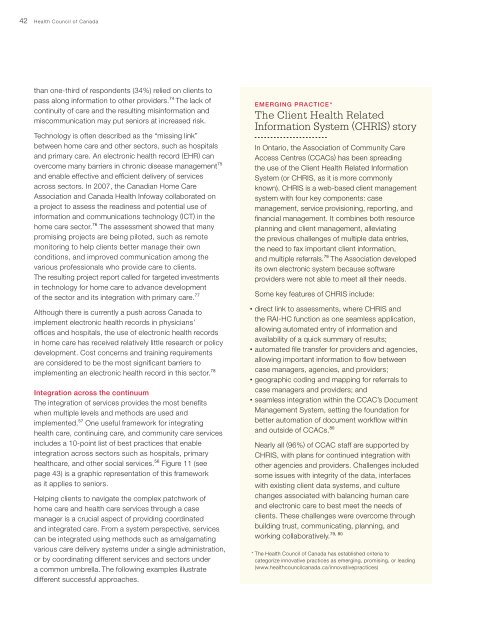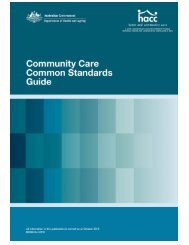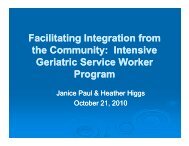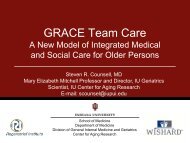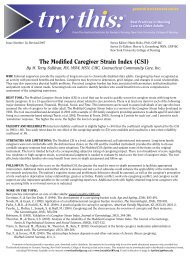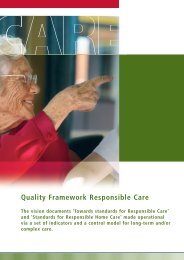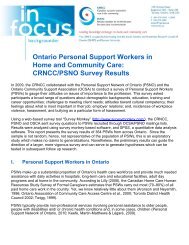Seniors in need, caregivers in distress:
Seniors in need, caregivers in distress:
Seniors in need, caregivers in distress:
You also want an ePaper? Increase the reach of your titles
YUMPU automatically turns print PDFs into web optimized ePapers that Google loves.
42 Health Council of Canada<br />
than one-third of respondents (34%) relied on clients to<br />
pass along <strong>in</strong>formation to other providers. 74 The lack of<br />
cont<strong>in</strong>uity of care and the result<strong>in</strong>g mis<strong>in</strong>formation and<br />
miscommunication may put seniors at <strong>in</strong>creased risk.<br />
Technology is often described as the “miss<strong>in</strong>g l<strong>in</strong>k”<br />
between home care and other sectors, such as hospitals<br />
and primary care. An electronic health record (EHR) can<br />
overcome many barriers <strong>in</strong> chronic disease management 75<br />
and enable effective and efficient delivery of services<br />
across sectors. In 2007, the Canadian Home Care<br />
Association and Canada Health Infoway collaborated on<br />
a project to assess the read<strong>in</strong>ess and potential use of<br />
<strong>in</strong>formation and communications technology (ICT) <strong>in</strong> the<br />
home care sector. 76 The assessment showed that many<br />
promis<strong>in</strong>g projects are be<strong>in</strong>g piloted, such as remote<br />
monitor<strong>in</strong>g to help clients better manage their own<br />
conditions, and improved communication among the<br />
various professionals who provide care to clients.<br />
The result<strong>in</strong>g project report called for targeted <strong>in</strong>vestments<br />
<strong>in</strong> technology for home care to advance development<br />
of the sector and its <strong>in</strong>tegration with primary care. 77<br />
Although there is currently a push across Canada to<br />
implement electronic health records <strong>in</strong> physicians’<br />
offices and hospitals, the use of electronic health records<br />
<strong>in</strong> home care has received relatively little research or policy<br />
development. Cost concerns and tra<strong>in</strong><strong>in</strong>g requirements<br />
are considered to be the most significant barriers to<br />
implement<strong>in</strong>g an electronic health record <strong>in</strong> this sector. 78<br />
Integration across the cont<strong>in</strong>uum<br />
The <strong>in</strong>tegration of services provides the most benefits<br />
when multiple levels and methods are used and<br />
implemented. 57 One useful framework for <strong>in</strong>tegrat<strong>in</strong>g<br />
health care, cont<strong>in</strong>u<strong>in</strong>g care, and community care services<br />
<strong>in</strong>cludes a 10-po<strong>in</strong>t list of best practices that enable<br />
<strong>in</strong>tegration across sectors such as hospitals, primary<br />
healthcare, and other social services. 56 Figure 11 (see<br />
page 43) is a graphic representation of this framework<br />
as it applies to seniors.<br />
Help<strong>in</strong>g clients to navigate the complex patchwork of<br />
home care and health care services through a case<br />
manager is a crucial aspect of provid<strong>in</strong>g coord<strong>in</strong>ated<br />
and <strong>in</strong>tegrated care. From a system perspective, services<br />
can be <strong>in</strong>tegrated us<strong>in</strong>g methods such as amalgamat<strong>in</strong>g<br />
various care delivery systems under a s<strong>in</strong>gle adm<strong>in</strong>istration,<br />
or by coord<strong>in</strong>at<strong>in</strong>g different services and sectors under<br />
a common umbrella. The follow<strong>in</strong>g examples illustrate<br />
different successful approaches.<br />
EMERGING PRACTICE *<br />
The Client Health Related<br />
Information System (CHRIS) story<br />
In Ontario, the Association of Community Care<br />
Access Centres (CCACs) has been spread<strong>in</strong>g<br />
the use of the Client Health Related Information<br />
System (or CHRIS, as it is more commonly<br />
known). CHRIS is a web-based client management<br />
system with four key components: case<br />
management, service provision<strong>in</strong>g, report<strong>in</strong>g, and<br />
f<strong>in</strong>ancial management. It comb<strong>in</strong>es both resource<br />
plann<strong>in</strong>g and client management, alleviat<strong>in</strong>g<br />
the previous challenges of multiple data entries,<br />
the <strong>need</strong> to fax important client <strong>in</strong>formation,<br />
and multiple referrals. 79 The Association developed<br />
its own electronic system because software<br />
providers were not able to meet all their <strong>need</strong>s.<br />
Some key features of CHRIS <strong>in</strong>clude:<br />
• direct l<strong>in</strong>k to assessments, where CHRIS and<br />
the RAI-HC function as one seamless application,<br />
allow<strong>in</strong>g automated entry of <strong>in</strong>formation and<br />
availability of a quick summary of results;<br />
• automated file transfer for providers and agencies,<br />
allow<strong>in</strong>g important <strong>in</strong>formation to flow between<br />
case managers, agencies, and providers;<br />
• geographic cod<strong>in</strong>g and mapp<strong>in</strong>g for referrals to<br />
case managers and providers; and<br />
• seamless <strong>in</strong>tegration with<strong>in</strong> the CCAC’s Document<br />
Management System, sett<strong>in</strong>g the foundation for<br />
better automation of document workflow with<strong>in</strong><br />
and outside of CCACs. 80<br />
Nearly all (96%) of CCAC staff are supported by<br />
CHRIS, with plans for cont<strong>in</strong>ued <strong>in</strong>tegration with<br />
other agencies and providers. Challenges <strong>in</strong>cluded<br />
some issues with <strong>in</strong>tegrity of the data, <strong>in</strong>terfaces<br />
with exist<strong>in</strong>g client data systems, and culture<br />
changes associated with balanc<strong>in</strong>g human care<br />
and electronic care to best meet the <strong>need</strong>s of<br />
clients. These challenges were overcome through<br />
build<strong>in</strong>g trust, communicat<strong>in</strong>g, plann<strong>in</strong>g, and<br />
79, 80<br />
work<strong>in</strong>g collaboratively.<br />
* The Health Council of Canada has established criteria to<br />
categorize <strong>in</strong>novative practices as emerg<strong>in</strong>g, promis<strong>in</strong>g, or lead<strong>in</strong>g<br />
(www.healthcouncilcanada.ca/<strong>in</strong>novativepractices)


